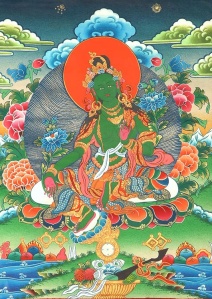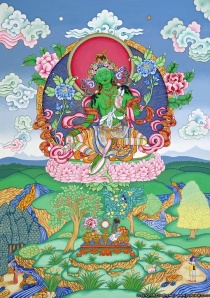The Green Tara is a Hindu/Buddhist goddess who represents a particular aspect of Tara, who is essentially a mother goddess. Buddhist tradition teaches that Tara was born from the bodhisattva Avalokiteshvara’s tears of compassion. This bodhisattva cried as he looked upon the suffering beings of this world and his tears created a lake. From this lake grew a lotus, and when the lotus opened it revealed the goddess Tara.
Tara is the goddess of universal compassion and possesses a love for living beings that is stronger than a mother’s love for her children. She also represents longevity, is a guardian of travel, and helps to protect her followers on their path to enlightenment.
There are different ideas about how the Tara was split into different colors, the most common being green and white. One thought is that the Green Tara was born from the tears of Avalokiteshvara’s right eye while the White Tara comes from the tears of the left eye.
The Green Tara sits in a half open lotus, representing night, while the White Tara sits in a fully opened lotus, representing day. They also represent different variations on the concept of universal compassion. The Green Tara possesses a quality of activity, and she is feistier. The White Tara is a more serene figure that carries herself with a particularly graceful air. The combination of the two demonstrates how the goddesses work day and night to end human suffering.
So back to the Green Tara… don’t worry, I’ll come back to the White Tara when we get to the letter “W”…
The Green Tara possesses a particularly youthful vigor, and as I mentioned, she is more active and feisty than the White Tara. She still represents compassion, but she is more likely to act to produce a compassionate result. She is green because in Buddhism the color represents activeness and accomplishment and this activeness can also be seen in how she is positioned on her lotus. Her left leg is folded and restful, while her right leg is more outstretched, allowing her to spring into action at any moment.
As with all Hindu and Buddhist iconography, the Green Tara is portrayed in a particular position, surrounded by particular Gods and Goddesses. Her left hand is in the mudra for refuge granting, while her right hand is in the boon granting, or gesture of generosity, mudra. She is often depicted holding closed blue lotuses, which represent purity and power.
A medieval devotional hymn for the Green Tara:
On a lotus seat, standing for realization of voidness,
(You are) the emerald-colored, one-faced, two-armed Lady
In youth’s full bloom, right leg out, left drawn in,
Showing the union of wisdom and art – homage to you!
Like the outstretched branch of the heavenly turquoise tree,
Your supple right hand makes the boon-granting gesture,
Inviting the wise to a feast of supreme accomplishments,
As if to an entertainment-homage to you!
Your left hand gives us refuge, showing the Three Jewels;
It says, “You people who see a hundred dangers,
Don’t be frightened- I shall swiftly save you!”
Homage to you!
Both hands signal with blue utpala (lotus) flowers,
“Samsaric beings! Cling not to worldly pleasures.
Enter the great city of liberation!”
Flower-goads prodding us to effort-homage to you!
I have had a relationship with the Green Tara for quite some time now. I was initially drawn to her because of her protective and active qualities. She is known to help people overcome fears and anxieties, and she is particularly effective in overcoming difficult situations. On many occasions she has helped me in a variety of ways.
Something I love about Paganism is that I feel free to follow the Goddesses and Gods that particularly speak to me. Some people both in and out of Paganism don’t support this picking and choosing of the deities and feel that is sacrilegious to do such a thing. But for me it really works. I have quite the little Parthenon of Gods and Goddesses that come from many different religions and cultures. I have a deep respect for these cultures and religions, but I feel I have formed my own loving, respectful relationship with each of the deities separate from whatever culture/religion they originated from. I know that statement could be inflammatory to some, but I am a strong believer in to each her own. As long as no harm and disrespect is done to others then mote it be.
The Green Tara (and the White one, too, but I’ll discuss her later) is close to my heart. Her picture is in my altar and I have a Green Tara ring that I wear almost every day. She teaches me compassion and aids me in relieving troubles and suffering. I also feel her protecting me on my journeys both physical and mental. She is a calming, grounding presence in my life, which I often need.
At the heart, Tara is another manifestation of the Mother Goddess figure found in almost every culture and religion. She takes on a slightly different flavor in Hinduism and Buddhism, but the Mother Goddess is there, ready to protect, guide, and comfort her children whenever they are suffering.
When writing this blog I drew upon my complied knowledge of the Tara and I referenced the backs of the many Tara prayer cards I own. I also referenced the Religion Facts website, which is where I found the medieval hymn: http://www.religionfacts.com/buddhism/deities/tara.htm



Mar 31, 2012 @ 04:55:57
I’ve always been interested in learning more about the Taras. Thanks for writing this to keep me thinking 🙂
Apr 03, 2012 @ 07:57:29
Thanks! They’re an interesting group of ladies, and the lesser known ones, like blue and red, are really fun to learn about as well.
Apr 05, 2012 @ 23:12:38
Thanks so much for this post! I have been drawn to Tara latley and this information was very helpful, especially the devotional hymn!